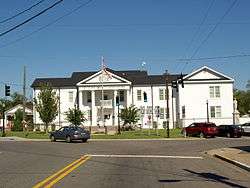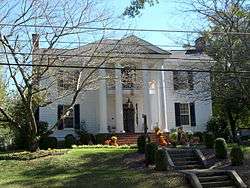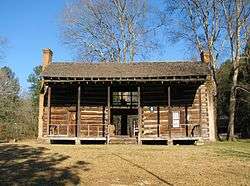Ashville, Alabama
Ashville is a city[3] in St. Clair County, Alabama, United States. Its population was 2,212 at the 2010 census, down from 2,260, at which time it was a town. Ashville is the county seat of St. Clair County[4] along with Pell City. It incorporated in 1822.[5]
Ashville, Alabama | |
|---|---|
St. Clair County Courthouse in Ashville | |
 Location of Ashville in St. Clair County, Alabama. | |
 Ashville Location in Alabama  Ashville Ashville (the United States)  Ashville Ashville (North America) | |
| Coordinates: 33.837°N 86.255°W | |
| Country | United States |
| State | Alabama |
| County | St. Clair |
| Government | |
| • Mayor | Derrick Mostella |
| Area | |
| • Total | 19.40 sq mi (50.25 km2) |
| • Land | 19.21 sq mi (49.76 km2) |
| • Water | 0.19 sq mi (0.49 km2) |
| Elevation | 577 ft (176 m) |
| Population (2010) | |
| • Total | 2,212 |
| • Estimate (2019)[2] | 2,365 |
| • Density | 123.09/sq mi (47.53/km2) |
| Time zone | UTC-6 (Central (CST)) |
| • Summer (DST) | UTC-5 (CDT) |
| ZIP code | 35953 |
| Area code(s) | 205, 659 |
| FIPS code | 01-02908 |
| GNIS feature ID | 0164539 |
| Website | www |
History
Ashville was initially founded as the community of St. Clairsville, but the name was changed to honor John Ash, the first white settler of the area who arrived in 1817.[5] He became the first county judge and later state senator. His log cabin stands in the city center. Philip Coleman originally owned the land on which the town stands, but he sold 30 acres to the five county commissioners, which included Ash, who was appointed by Gov. Thomas Bibb to establish a new county seat for St. Clair. It was designated the county seat in 1821 and the village incorporated in 1822. The first courthouse, also a log structure, was built two years later. It was replaced in 1844 with the current courthouse building.
In 1890, a group of investors organized the Tennessee River, Ashville and Coosa Railroad Company, and planned to build a railroad line from Sheffield to Anniston via Ashville. It managed to build to Ashville from Whitney, connecting the town to the Alabama Great Southern Railroad. However, it went bankrupt during the mid-1890s, and the tracks were dismantled and sold for scrap.[6]
Electric lights came to Ashville in 1891, and the first telephone company was chartered in the same year. Residents in the southern half of the county often complained of the difficulty of traveling to Ashville over Backbone Mountain, which divides the county, so the state legislature authorized a satellite county seat to be established in Pell City in 1907 on the southern side of the mountain.
Geography
Ashville is located at 33°50′37″N 86°15′59″W (33.843737, -86.266274).[7]
According to the United States Census Bureau, the town had a total area of 19.4 square miles (50 km2), of which 19.3 square miles (50 km2) is land and 0.1 square mile (0.26 km2) (0.46%) is water.
Climate
The climate in this area is characterized by hot, humid summers and generally mild to cool winters. According to the Köppen climate classification system, Ashville has a humid subtropical climate, abbreviated "Cfa" on climate maps. [8]
| Climate data for Ashville, Alabama | |||||||||||||
|---|---|---|---|---|---|---|---|---|---|---|---|---|---|
| Month | Jan | Feb | Mar | Apr | May | Jun | Jul | Aug | Sep | Oct | Nov | Dec | Year |
| Average high °C (°F) | 13 (55) |
13 (55) |
19 (66) |
23 (73) |
28 (83) |
32 (89) |
32 (90) |
32 (90) |
30 (86) |
24 (76) |
18 (64) |
12 (53) |
23 (73) |
| Average low °C (°F) | 1 (33) |
1 (33) |
6 (43) |
9 (48) |
13 (56) |
18 (65) |
20 (68) |
19 (67) |
16 (60) |
9 (49) |
3 (38) |
1 (33) |
9 (49) |
| Average precipitation mm (inches) | 130 (5.3) |
140 (5.4) |
160 (6.4) |
120 (4.6) |
91 (3.6) |
94 (3.7) |
130 (5) |
99 (3.9) |
91 (3.6) |
66 (2.6) |
86 (3.4) |
130 (5.1) |
1,330 (52.5) |
| Source: Weatherbase[9] | |||||||||||||
Demographics
Ashville
| Historical population | |||
|---|---|---|---|
| Census | Pop. | %± | |
| 1860 | 117 | — | |
| 1900 | 362 | — | |
| 1910 | 278 | −23.2% | |
| 1920 | 349 | 25.5% | |
| 1930 | 369 | 5.7% | |
| 1940 | 385 | 4.3% | |
| 1950 | 494 | 28.3% | |
| 1960 | 973 | 97.0% | |
| 1970 | 986 | 1.3% | |
| 1980 | 1,489 | 51.0% | |
| 1990 | 1,494 | 0.3% | |
| 2000 | 2,260 | 51.3% | |
| 2010 | 2,212 | −2.1% | |
| Est. 2019 | 2,365 | [2] | 6.9% |
| U.S. Decennial Census[10] 2013 Estimate[11] | |||
Ashville first appeared on the 1860 U.S. Census as an incorporated town.[12] It would not appear again on the census as a town until 1900. See also precinct below.
2000 Census data
As of the census of 2000,[13] there were 2,260 people, 814 households, and 608 families residing in the town. The population density was 116.9 people per square mile (45.1/km2). There were 905 housing units at an average density of 46.8 per square mile (18.1/km2). The racial makeup of the town was 69.42% White, 26.55% Black or African American, 0.18% Native American, 0.18% Asian, 0.31% Pacific Islander, 1.81% from other races, and 1.55% from two or more races. 2.88% of the population were Hispanic or Latino of any race.
There were 814 households, out of which 37.0% had children under the age of 18 living with them, 56.6% were married couples living together, 14.1% had a female householder with no husband present, and 25.2% were non-families. 22.7% of all households were made up of individuals, and 11.2% had someone living alone who was 65 years of age or older. The average household size was 2.64 and the average family size was 3.10.
In the town the population was spread out, with 25.7% under the age of 18, 8.9% from 18 to 24, 28.2% from 25 to 44, 23.2% from 45 to 64, and 14.0% who were 65 years of age or older. The median age was 36 years. For every 100 females, there were 102.3 males. For every 100 females age 18 and over, there were 100.1 males.
The median income for a household in the town was $31,509, and the median income for a family was $38,355. Males had a median income of $31,081 versus $21,914 for females. The per capita income for the town was $15,867. About 11.4% of families and 15.1% of the population were below the poverty line, including 14.1% of those under age 18 and 18.3% of those age 65 or over.
2010 census
As of the census of 2010,[14] there were 2,212 people, 793 households, and 597 families residing in the town. The population density was 114.6 people per square mile (40.1/km2). There were 888 housing units at an average density of 46.0 per square mile (17.7/km2). The racial makeup of the town was 75.8% White, 20.3% Black or African American, 0.2% Native American, 03% Asian, 0% Pacific Islander, 1.4% from other races, and 2.0% from two or more races. 3.8% of the population were Hispanic or Latino of any race.
There were 793 households, out of which 29.6% had children under the age of 18 living with them, 54.9% were married couples living together, 16.6% had a female householder with no husband present, and 24.7% were non-families. 21.8% of all households were made up of individuals, and 9.0% had someone living alone who was 65 years of age or older. The average household size was 2.68 and the average family size was 3.12.
In the town the population was spread out, with 24.0% under the age of 18, 10.0% from 18 to 24, 25.9% from 25 to 44, 26.9% from 45 to 64, and 13.3% who were 65 years of age or older. The median age was 37.3 years. For every 100 females, there were 99.6 males. For every 100 females age 18 and over, there were 100.3 males.
The median income for a household in the town was $33,321, and the median income for a family was $34,607. Males had a median income of $32,026 versus $30,033 for females. The per capita income for the town was $16,419. About 14.2% of families and 19.9% of the population were below the poverty line, including 32.0% of those under age 18 and 6.2% of those age 65 or over.
Ashville Precinct/Division
| Historical population | |||
|---|---|---|---|
| Census | Pop. | %± | |
| 1870 | 922 | — | |
| 1880 | 1,443 | 56.5% | |
| 1890 | 2,017 | 39.8% | |
| 1900 | 2,446 | 21.3% | |
| 1910 | 2,067 | −15.5% | |
| 1920 | 2,289 | 10.7% | |
| 1930 | 2,379 | 3.9% | |
| 1940 | 2,494 | 4.8% | |
| 1950 | 2,423 | −2.8% | |
| 1960 | 4,402 | 81.7% | |
| 1970 | 4,895 | 11.2% | |
| 1980 | 6,347 | 29.7% | |
| 1990 | 6,742 | 6.2% | |
| 2000 | 8,208 | 21.7% | |
| 2010 | 8,449 | 2.9% | |
| U.S. Decennial Census[15] | |||
The Ashville Beat (St. Clair County 1st Beat) first appeared on the 1870 U.S. Census. In 1890, "beat" was changed to "precinct." In 1960, the precinct was changed to "census division" as part of a general reorganization of counties.[16]
April 27, 2011 tornado
On the eve of April 27, 2011, an EF-4 tornado ripped through the Shoal Creek Valley community of Ashville, killing 13 residents. The tornado also destroyed hundreds of thousands of dollars' worth of property including homes, livestock, timberland, and farm equipment. Rescuers from neighboring communities immediately responded after the twister swept through the valley; however, due to the abundance of fallen timber blocking the roads and the remoteness of the community, many victims were forced to wait hours before aid could arrive. Following the devastation, Governor Robert Bentley visited the community along with officials from the Alabama Emergency Management Agency and the Federal Emergency Management Agency. The community received both federal and state disaster aid for several weeks following the destructive tornado. With numerous families in the community left without homes, they were forced to seek shelter in hotels and homes of family members. Local police instituted a curfew as well as various home protection policies to insure that what property was left was taken care of.
Education
- St. Clair County School System
- Ashville Elementary School
- Principal: Lisa Glasgow
- Guidance Counselor: Summer Burke
- Principal: Lisa Glasgow
- Ashville Middle School
- Principal: Rusty St. John
- Assistant Principal: Meme Stafford
- Guidance Counselor: Kerry Montgomery
- Principal: Rusty St. John
- Ashville High School
- Principal: Janet Johnson
- Assistant Principal: Bobby Crump
- Guidance Counselor: Candice Cranford
- Mascot: Bulldogs - School Colors: Kelly Green and White
- Principal: Janet Johnson
- Ashville Elementary School
Notable people
- Rufus W. Cobb, Governor of Alabama from 1878–1882
- John Grass, Ashville High School: c/o 1985, head football coach for Jacksonville State University
- Howard Hill, Hollywood archer, called "The World's Greatest Archer," winning 196 field archery competitions. Also stunt double for actor Errol Flynn. Buried in Ashville
Photo Gallery
 Court Street, Ashville
Court Street, Ashville First Baptist Church, Ashville
First Baptist Church, Ashville St. Clair County Courthouse, Ashville
St. Clair County Courthouse, Ashville St. Clair County Courthouse, Ashville
St. Clair County Courthouse, Ashville Inzer House, Ashville
Inzer House, Ashville Dr. James J. Bothwell House, Ashville
Dr. James J. Bothwell House, Ashville Judge Elisha Robinson House, Ashville
Judge Elisha Robinson House, Ashville John Looney House, Ashville
John Looney House, Ashville
References
- "2019 U.S. Gazetteer Files". United States Census Bureau. Retrieved June 29, 2020.
- "Population and Housing Unit Estimates". United States Census Bureau. May 24, 2020. Retrieved May 27, 2020.
- U.S. Census change list Archived August 6, 2010, at the Wayback Machine
- "Find a County". National Association of Counties. Archived from the original on 2011-05-31. Retrieved 2011-06-07.
- http://www.encyclopediaofalabama.org/article/h-2562
- Poor's Manual of the Railroads of the United States, Vol. 27 1894
- "US Gazetteer files: 2010, 2000, and 1990". United States Census Bureau. 2011-02-12. Retrieved 2011-04-23.
- Climate Summary for Ashville, Alabama
- "Weatherbase.com". Weatherbase. 2013. Retrieved on November 2, 2013.
- "U.S. Decennial Census". Census.gov. Retrieved June 6, 2013.
- "Annual Estimates of the Resident Population: April 1, 2010 to July 1, 2013". Retrieved June 3, 2014.
- https://www2.census.gov/library/publications/decennial/1860/population/1860a-04.pdf?, 1860 AL Census
- "U.S. Census website". United States Census Bureau. Retrieved 2008-01-31.
- "U.S. Census website". United States Census Bureau. Retrieved 2015-08-09.
- "U.S. Decennial Census". Census.gov. Retrieved June 6, 2013.
- http://www2.census.gov/prod2/decennial/documents/37721510v1p2ch2.pdf, 1960 AL Census
